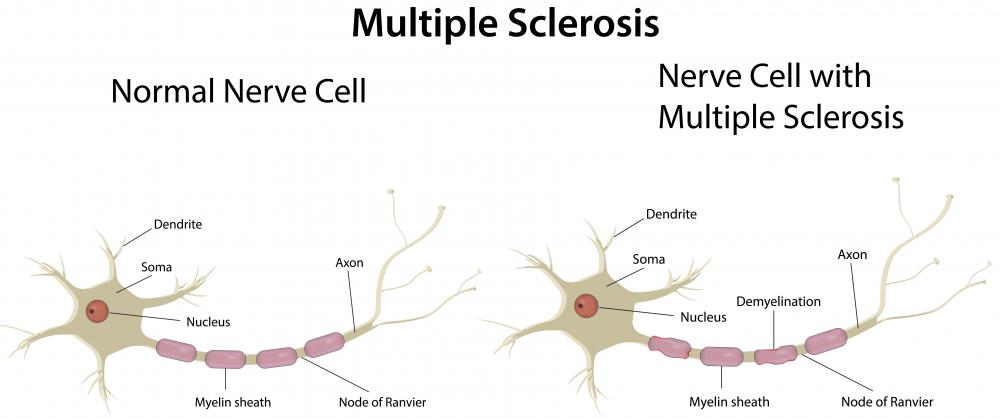At TheHealthBoard, we're committed to delivering accurate, trustworthy information. Our expert-authored content is rigorously fact-checked and sourced from credible authorities. Discover how we uphold the highest standards in providing you with reliable knowledge.
What are Oligodendrocytes?
Oligodendrocytes, also known as oligodendroglia, are a type of brain cell in the central nervous system that belongs to the glial cell family. The main purpose of glial cells is maintenance and support of nervous system cells. Oligodendrocytes support neurons by producing a substance called myelin, which is composed of approximately 80 percent lipid and 20 percent protein. Essentially, oligodendrocytes wrap the fatty myelin around the nerve-transmitting extensions of nerve cells, which are called axons. These myelin sheaths are approximately .039 inches (about 1 mm) thick, and this sheath acts as insulation for axons – this results in the fast conduction of nerve impulses along axons.
Schwann cells are another type of glial cell that similarly functions to supply myelination to axons. There are, however, several crucial differences between Schwann cells and oligodendrocytes. First, Schwann cells myelinate neurons in the peripheral nervous system, whereas oligodendrocytes myelinate neurons in the central nervous system. Second, a single oligodendrocyte has the capacity to myelinate up to approximately 50 axons, whereas Schwann cells can myelinate only one axon.

Oligodendrocytes arise from oligodendrocyte precursor cells (OPC). In general, a precursor cell is a type of partially differentiated cell that retains the ability to differentiate into several functionally related cell types, but has lost the ability to differentiate into multiple cell types. Small populations of OPCs remain in adults, and OPCs are thought to compose approximately 5 to 10 percent of the adult glial cell population. In response to certain mechanical injuries or viral infections, it is believed that these OPCs are stimulated to grow and replace damaged oligodendrocytes in healthy individuals, resulting in remyelination of neurons.

The myelin sheaths can be compared to the insulation on electrical wires, preventing leakage of ions and maintaining the electrical potential of axons. Therefore, a myelinated axon is much more efficient at transducing signal than an unmyelinated axon. There are several pathological conditions associated with the demyelination of axons, the most common of which is multiple sclerosis (MS).

MS is an autoimmune disease in which the immune system attacks and damages the myelin sheath, resulting in faulty transduction of nerve signals along axons. Leukodystrophies arise from insufficient myelin production during growth, resulting in a variety of symptoms that include the slowing of mental and physical development, progressive loss of movement, and progressive deterioration of senses, such as vision and hearing. Other conditions associated with damage to oligodendrocytes include cerebral palsy, the disabilities resulting from a stroke, and paralysis caused by spinal cord injury.
AS FEATURED ON:
AS FEATURED ON:














Discussion Comments
@SkyWhisperer - I believe that we will get there too. However, I think we should tread carefully with claims of miracle cures for the time being.
I knew someone who had muscular sclerosis and while he was getting treatment that kept him from getting worse, he was not cured from what I could tell.
I did some research online and read that some scientists had claimed to have done things with stem cells to cure – or at least combat – the progression of muscular sclerosis.
Indeed, finding a cure muscular sclerosis was held up as one of the rationales for accelerated investment into stem cell research. I couldn’t find any solid evidence to back up the claims as of yet; so far, I’ve read only anecdotal accounts. But again, like you, I do believe we will find a cure some day.
So that’s what causes muscular sclerosis, a breakdown in the oligodendrocytes myelin function. Given how important this “insulation” is to ensuring the body can properly transmit nerve impulses, I would hope that medical science would be looking for ways to remedy the condition.
I can see that it would be a tall order to prescribe some treatment that would effectively reinsulate your nerves, so to speak, given that the nerve transmitting axons are so abundant in the body.
I think you would have to find some way to stimulate myelin growth in the body, or perhaps inject stem cells or something like that which have the capability of regrowing the myelin on its own.
I don’t doubt that with the advances in medical science, we will soon find such a breakthrough.
Post your comments